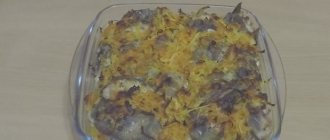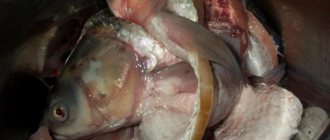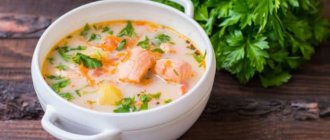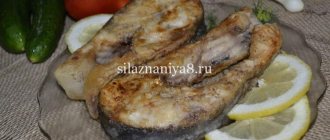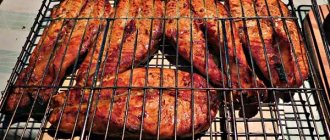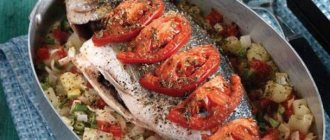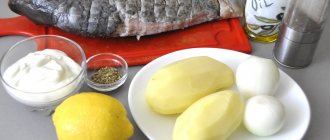Pollock fish is a marine representative that lives in deep waters.
It is distributed throughout the Atlantic, migrating south in the fall. In summer, fish can be found off the Murom coast. Cooking fish in batter?
- Yes 83%, 510 votes
510 votes 83%510 votes - 83% of all votes
- No 13%, 83 votes
83 votes 13%
83 votes - 13% of all votes
- I don't eat fish 4%, 23 votes
23 votes 4%
23 votes - 4% of all votes
Total votes: 616
17.04.2020
×
You or from your IP have already voted.
Pollock: what kind of fish and where is it found?
Pollock is a predatory marine fish from the cod family. It lives in the waters of the Atlantic near the coasts of Norway and Iceland. In Russia it is caught on an industrial scale, mainly in Murmansk.
Pollock has an elongated body with a pointed head, silver in color with a characteristic light stripe. It can reach up to 90 cm in length and weigh up to 17 kg. A distinctive feature of this fish is its elongated lower lip. Pollock is considered a close “relative” of hake, cod, haddock and pollock. The predator feeds mainly on crustaceans, plankton and small fish.
Due to its habitat in salt water, the meat of this fish is protected from infection by parasites, so it can be pickled and salted without additional heat treatment. Recently, pollock catches have increased so much, due to the huge demand for meat, that the entire catch had to be regulated and controlled in order to stabilize the population.
People sometimes confuse saury and pollock, but these are two different fish, and the confusion most likely arises due to the fact that saury can be found more often on the shelves of our stores.
Pollock in natural conditions
Description of fish with photo
Pollock belongs to the cod family. She is a relative of cod, pollock, and hake. The fish has an oblong body, which widens from the head to the middle and narrows again towards the tail. The body length of an adult predator reaches 60-90 cm, sometimes up to a meter, with a weight of 17 kg. Lives about 30 years.
The description of the appearance looks like this. The back has dark greenish colors, sometimes close to black. The side body is lighter, the belly is silvery. The lateral line is clearly defined, it is clearly visible from the head to the tail. The fish has 3 dorsal fins and 2 anal fins.
A distinctive feature of pollock is its protruding lower jaw.
The fish has a medium-sized mouth and a short, hard barbel on the lower jaw. It is characteristic of all representatives of the cod family.
Pollock is a schooling fish and is caught all year round. Most of the inhabitants were found in the northern territory. Until recently, fishing was small, but people appreciated the taste and benefits of meat. Reviews are only good.
Photo of sea life
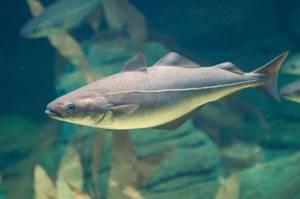
Chemical composition of pollock meat
Pollock meat has a dense consistency, slightly grayish color, pleasant taste, it cannot be called dry. This meat should appeal to gourmets and connoisseurs of fish dishes. It is much cheaper than cod, but in terms of taste and health benefits it is no worse.
Of the vitamins that are present in pollock meat, we can note - B vitamins (B1, B2, B12), as well as Vitamin A, Vitamin K, Vitamin PP and E. The most minerals are sodium, potassium, iron, selenium, zinc , phosphorus, manganese, magnesium, nickel.
And her caviar is white
Pollock caviar tastes very good. The eggs are small and dense. Pollock caviar is classified as white caviar, despite the fact that it appears reddish in color.
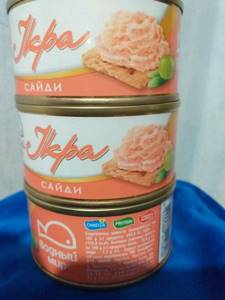
It is interesting that white caviar, in terms of its beneficial properties, actually differs little from the famous red and black ones. Pollock caviar can be salted, boiled and fried.
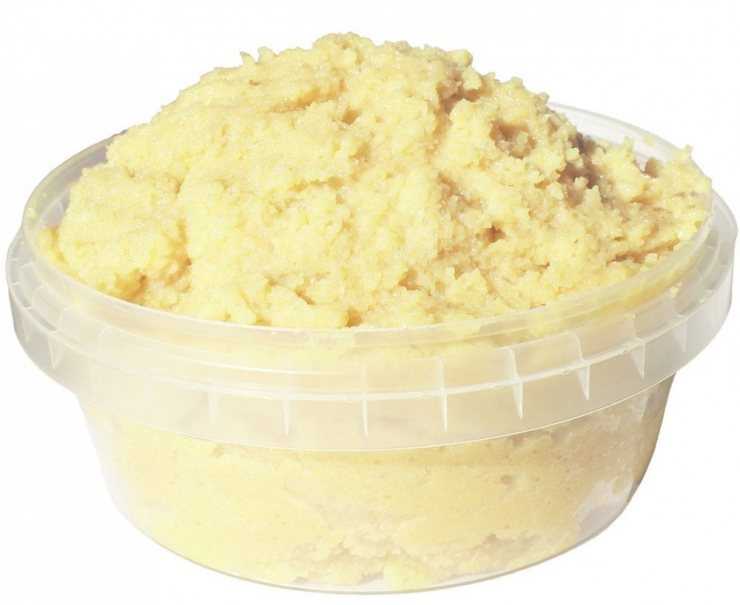
There are a lot of benefits from it, but there is practically no harm - unless, of course, you suffer from allergies. It contains even more useful substances than the fish itself.
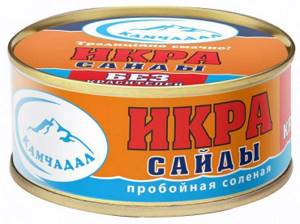
Its use normalizes metabolism and is an excellent remedy for the prevention of heart and thyroid diseases.

Pollock caviar is an indispensable product for everyone who is recovering from a long-term illness and who leads an active lifestyle and wants to always be full of energy.

Pollock: beneficial properties
1. Phosphorus is necessary for the proper functioning of the entire musculoskeletal system, as well as for the functioning of the brain.
2. Iodine normalizes the functioning of the thyroid gland.
3. Calcium is necessary to strengthen bones and tooth enamel.
4. Zinc is needed for the proper functioning of the hormonal system in men and women.
5. Cobalt and nickel are necessary for proper hematopoiesis and normalization of blood pressure.
6. Molybdenum helps improve metabolic processes in the body and normalize hemoglobin levels.
7. The complex of vitamins is necessary for the proper functioning of the liver, thyroid gland and pancreas.
8. Regular consumption of pollock will help strengthen the immune system and speed up the process of cell regeneration.
9. Due to the high content of folic acid, this fish is recommended to be included in the diet of pregnant women and couples who are planning to have a child.
10. Fish is rich in proteins and is almost as nutritional as lean beef, so it can be included in the diet of people who do not eat meat. Moreover, proteins from fish are absorbed much better than proteins from pork or beef.
11. Pollock meat should be in the diet of people suffering from diseases of the gastrointestinal tract, such as gastritis, pancreatitis, stomach or duodenal ulcers.
12. Young children can gradually introduce saury dishes into their diet from the age of eight months in the form of soft puree cutlets or light soups.
On a note! The healthiest pollock is baked or steamed; this meat is recommended to be consumed in the postoperative period for a speedy recovery of the body.
Canned pollock in oil
Extinguishing
Another dietary option for a dish of pollock is stewed with vegetables.
We will need:
- pollock fillet – 500-700 gr.;
- onion – 1-2 heads;
- carrots – 1 pc.;
- bell pepper – 1 pc.;
- tomatoes – 3-4 pcs. (can be replaced with 2-3 tablespoons of tomato paste);
- salt and pepper to taste;
- fresh greens or dried Provençal herbs;
- vegetable oil – 3-4 tbsp. spoons.
Peel the onions and carrots, cut into small cubes. Pour oil into a heated frying pan and add onions. When it becomes translucent, add carrots. Simmer for 3-4 minutes, then add diced peppers and tomatoes. Season with salt and pepper, add 0.5 teaspoon of Provençal herbs, simmer for another 3-4 minutes and add fish fillet cut into 3 cm strips to the vegetables. Simmer uncovered for about 10 minutes. The finished dish can be sprinkled with any herbs.
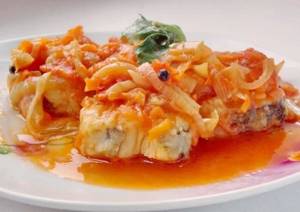
Canned pollock
Pollock meat is tasty and healthy in any form, and canned meat is no exception. The best are considered to be canned goods prepared immediately after extraction directly on the ship. As a rule, the manufacturer of such products is Murmansk or Norway.
From canned food you can find:
1. Pollock in oil or its own juice.
2. Pollock with vegetables.
3. Liver or caviar.
Pollock caviar has a slightly salty taste, is very tender, and is good for sandwiches with butter.
Pollock liver is very similar to cod liver and is also rich in Vitamin D; it can be used to prepare salads or sandwiches.
When choosing canned food, pay attention to the composition! Apart from the fish itself, water, black pepper and spices, there should be no other preservatives or food additives. The shelf life of such products is usually two years.
Steak pollocks in nut breading
Pollock in a baking sleeve
The recipe for pollock in the oven is a very simple way to prepare delicious fish. If you don’t have time, then you don’t need to marinate the steaks, but rub them with salt and spices and immediately place them in a baking bag. In order for the pollock to brown at least a little, after half an hour of baking, the sleeve is cut and cooked to the desired brownness.
Ingredients:
- pollock – 1 piece;
- salt, spices;
- vegetable oil – 1 tbsp. spoon;
- parsley.
Preparation
- The fish is cleaned, cut into portions, rubbed with salt and spices.
- Place the fish in a container, cover with a lid and put it in the refrigerator overnight.
- Place the prepared pieces of fish into a baking sleeve, lightly sprinkle with oil, and tie the edges of the sleeve.
- Bake fish at 180 °C.
- After 40 min. The baked pollock will be ready.
How to cook
Pollock meat will be tasty and healthy in any form. The simplest option is to fry the fillet in a frying pan in batter or any breading until golden brown with the addition of various spices, but you can boil, bake, can, or roll it into minced meat for cutlets.
This fish can be smoked and marinated. You will get very tasty and juicy meat if you bake it in foil with the addition of herbs, fish spices, lemon juice, you can add a little white wine and vegetables. And saury fish soup turns out light and rich; this first course can become the most favorite soup in your family.
Saury meat is suitable for preparing the filling for pies and kulebyaki. It goes well with various products; saury meat makes very tasty fish salads.
I recommend:
Saida – 9 most delicious recipes
Canned pollock caviar
Recipe for baked pollock in foil with vegetables
The most correct and delicious way to prepare this fish is to bake it in foil in the oven. This way pollock retains more of its beneficial properties and is juicier.
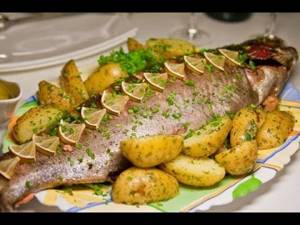
You will need:
- 1 PC. – pollock carcass up to 1 kg
- 2-3 pcs. – small onions
- 1 PC. – big carrot
- 2+2 tbsp. spoons - vegetable oil
- 2 tbsp. spoons - sour cream and tomato paste (you can use only sour cream)
- Salt, pepper, paprika - to taste
- Lemon juice from half a lemon or 2-3 tbsp. spoons of white wine
How to cook:
1. Clean the pollock carcass, cut off the fins, rinse well, dry with a paper towel, and sprinkle with lemon juice.
2. Mix all the spices with salt, grate the fish, leave for 10-15 minutes to marinate.
3. Peel the onions and carrots, cut the onions into half rings, coarsely grate the carrots. Fry the onion in vegetable oil until soft, add the carrots, and simmer for literally another 10 minutes.
4. Add sour cream and tomato paste to the vegetable mass, stir, stuff the fish. If there is a lot of filling, then put more on top of the carcass.
5. Grease baking foil with vegetable oil, place the pollock into it and wrap it.
6. Place in the oven for baking for 30-40 minutes at t=200 degrees.
Calorie content per 100 g. – 115 kcal
Bon appetit!
How to choose and store correctly
There are general recommendations that must be followed when selecting and storing any fish, and pollock is no exception:
1. Attractive, fresh appearance, without chapping, with a natural shine and without an unpleasant odor. The carcass should be elastic and return to its original shape when pressed.
2. Pay attention to the packaging date and shelf life if you purchase canned or frozen fish.
3. There should not be a lot of ice on frozen fish. A large amount of ice indicates that the fish has been defrosted several times. With such a product you can easily get food poisoning, and it will also be very dry! It is better to buy frozen fish in a transparent bag; if this is not the case, then shake the packaging well. A strong and characteristic noise indicates that there is a lot of ice inside.
4. A fresh carcass can be stored in the refrigerator for no more than four hours.
5. If the refrigerator is filled with ice, the shelf life increases to 3-4 days.
6. The carcass can be stored in the freezer for up to 8 months.
I recommend:
Hake (hake) - what kind of fish, composition, calorie content, benefits and harm
Haddock - what kind of fish, description, photo, benefits, how to cook, harm
With carrots and onions
You will need:
- pollock – 1 kg;
- carrots – 2 pcs.;
- onion – 1 pc.;
- lemon – 1/2 pcs.;
- salt, seasonings, bay leaf to taste.
The fish is washed, cleaned and dried. Cut into slices and coat each piece with a mixture of lemon juice, spices and salt. Place in the refrigerator for 30-40 minutes. The carrots are chopped into thin strips; you can use a Korean carrot grater. Onions are cut into rings. Place vegetables, fish, bay leaves on a sheet of foil and seal tightly. Place the entire structure in the oven for 40 minutes at a temperature of 180 degrees.
For convenience, you can buy fish fillet or steak to save time on cleaning and gutting. Saida can be served as an independent dish, then it will contain vegetables as a side dish. This recipe also goes well with boiled rice and potatoes.
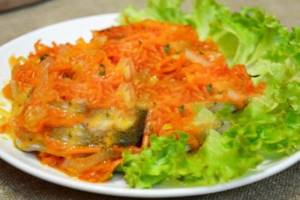
Saida: harm and contraindications
1. People with allergies to seafood should be careful when consuming this fish and exclude it from the diet at the slightest sign of an allergic reaction.
2. Give pollock meat to small children with caution, limit yourself to a minimum portion and monitor the child’s body’s reaction to the new product.
3. All inhabitants of the sea and pollock, no exception, can accumulate large amounts of mercury, so before purchasing it is better to check with the seller that it is safe.
Pollock with potatoes in the oven
Pollock with potatoes is not only very tasty, but also a very filling delicacy. In this case, all components are placed on a baking sheet in layers, and then they are poured with an egg-milk mixture. You can do it differently: small pieces of fish can be mixed with potatoes and other ingredients and baked.
Ingredients:
- potatoes – 10 pcs.;
- pollock – 1 kg;
- oil – 2 tbsp. spoons;
- milk – 3/4 cup;
- eggs – 2 pcs.;
- salt, pepper - to taste.
Preparation
- Sprinkle the sliced fish with salt and pepper.
- Pre-cooked potatoes in their skins are peeled and cut into slices.
- Place the fish in a greased form, then a layer of potatoes.
- All this is salted, poured with a mixture of milk and eggs and sent to the oven.
- Bake at 180 °C for about 40 minutes.
- Before serving, sprinkle the dish with chopped herbs.
general characteristics
The habitat of pollock is the entire North Atlantic. This fish migrates over long distances and is therefore found from Greenland to the New York coast, as well as in waters near Norway and Iceland. It lives at a depth of 200-250 meters.
Externally, pollock is very similar to cod, so they are sometimes jokingly called “twin brothers.” The fish has a pointed dark head, an olive-colored back, and lighter yellowish-gray sides. The belly of pollock is milky white, sometimes silvery-grayish.
A distinctive characteristic of pollock is a light, almost straight stripe, which is clearly visible on the side of the fish’s body.
The average body length of an adult pollock is from 60 centimeters to a meter, but there are real giants up to 120 centimeters long.
Large pollock can weigh up to seventeen kilograms, and the largest specimen to date, which was caught by a Norwegian fisherman, weighed 22.3 kg. The lifespan of pollock is up to thirty years.
Saida is a predator. Young fish feed mainly on the eggs of other fish and crustaceans, while adults hunt for schooling fish of smaller sizes: herring, capelin, sand lance. At the same time, pollock usually hunts in huge flocks - predators surround future prey on all sides, and the noise they make can be heard even on the surface of the sea.
In a slow cooker
To prepare pollock in a slow cooker, you need the following components:
- 4 pieces of pollock;
- 80 g sour cream 25% fat;
- 1/2 carrot;
- 50 g processed cheese;
- 20 ml lemon juice;
- 1/2 tsp. crushed pepper and table salt;
- 5 g dill;
- 1 petal of green onion.
Pollock fish, recipes for which are popular in many countries, is prepared in a slow cooker according to the following scheme:
- First you need to marinate the pollock. To do this, rub it on all sides with a mixture of pepper and table salt, pour over lemon juice and leave the fish in a warm place for 35 - 40 minutes. The marinated pieces of pollock should be placed on foil, the size of which should be 40x30 cm.
- Next, you need to peel the carrots, rinse under running water and chop using a coarse grater. Grated carrots should be lightly salted and placed on top of the pollock pieces.
- Then you will need to grate the processed cheese on a fine-hole grater and mix it with sour cream. The cheese must be pre-cooled in the freezer to make it easier to grate.
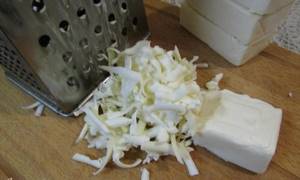
- Pour the finished sauce over the fish, wrap it tightly in foil and place it in the multicooker bowl. The pollock should be prepared by setting the “Baking” mode for approximately 40 – 45 minutes. After the time has passed, you must set the “Heating” mode for 15 minutes. and continue cooking.
- Carefully remove the finished fish from the bowl, unwrap the foil and arrange the pieces into portions, sprinkling each with a small amount of dill and chopped green onions.
The benefits of sea fish
Sea fish, including pollock, have a very important advantage over river fish. Any creatures living in rivers and ponds are susceptible to helminthic infestation and parasites, so when eating river fish there is a high risk of contracting opisthorchiasis and other dangerous diseases. And the fish that live in the sea practically do not suffer from parasites due to the peculiarities of the marine ecosystem.
Therefore, if we examine this issue from a sanitary and hygienic point of view, sea fish is much safer than river fish. Eating this fish and its other, more famous “relatives” is an excellent way to enrich your daily diet with protein and other beneficial substances.
History and geography of the product
Pollock is one of the popular fish of the cod family. The main habitat of this valuable fish today is considered to be the entire Atlantic ( almost from the shores of Greenland to New York itself
), Barents and White Seas. The habitat depth of pollock is 200-250 m. The main source of food for the fish is small mollusks and small schooling fish. All year round, pollock migrates very intensively: in the spring, moving closer to the north, and in the autumn, on the contrary, towards the south. In summer, pollock's favorite place is the coast of Murmansk. This is where mass fishing takes place to replenish the shelves of domestic stores.
A few decades ago, pollock was not popular either among fishermen or housewives. Catching this fish was considered a low-grade fishery that did not bring much income. But since the middle of the last century, the number of pollock in the Atlantic has increased significantly, and its catch has accordingly increased. Now pollock is mined almost all year round - its reserves are so large in the depths of the cold seas. At the same time, pollock itself ranks fourth in terms of meat value after haddock and cod.
The fish spawns at a depth of at least 200 m above soft sandy soil. The optimal temperature for laying eggs is from 8 to 10 degrees Celsius. In this case, the salt level in the water should be at least 35%. After small eggs are laid in the water, the current carries the cod offspring over many hundreds of kilometers.
Fishing for pollock is practiced off the coast of Norway, off the North Cape and in the North Sea. Today, the reserves of valuable fish in the northern part are still stable. But the southern side has greatly reduced the population of pollock. And in order not to completely lose commercial fish, regulation of its catch is being introduced by introducing restrictions on production in certain areas. Monitoring compliance with established norms and rules is carried out through the introduction of a method of marking the place where fish were caught.
An excerpt characterizing Silver pollock
- Well, is it true that there is peace and surrender? – asked Nesvitsky. - I'm asking you. I don’t know anything except that I got to you by force. - What about us, brother? Horror! “I’m sorry, brother, they laughed at Mak, but it’s even worse for us,” Nesvitsky said. - Well, sit down and eat something. “Now, prince, you won’t find any carts or anything, and your Peter, God knows where,” said another adjutant. -Where is the main apartment? – We’ll spend the night in Tsnaim. “And I loaded everything I needed onto two horses,” said Nesvitsky, “and they made me excellent packs.” At least escape through the Bohemian mountains. It's bad, brother. Are you really unwell, why are you shuddering like that? - Nesvitsky asked, noticing how Prince Andrei twitched, as if from touching a Leyden jar. “Nothing,” answered Prince Andrei. At that moment he remembered his recent clash with the doctor’s wife and the Furshtat officer. -What is the commander-in-chief doing here? - he asked. “I don’t understand anything,” said Nesvitsky. “All I understand is that everything is disgusting, disgusting and disgusting,” said Prince Andrei and went to the house where the commander-in-chief stood. Passing by Kutuzov's carriage, the tortured horses of the retinue and the Cossacks speaking loudly among themselves, Prince Andrei entered the entryway. Kutuzov himself, as Prince Andrei was told, was in the hut with Prince Bagration and Weyrother. Weyrother was an Austrian general who replaced the murdered Schmitt. In the entryway little Kozlovsky was squatting in front of the clerk. The clerk on an inverted tub, turning up the cuffs of his uniform, hastily wrote. Kozlovsky’s face was exhausted - he, apparently, had not slept at night either. He looked at Prince Andrei and did not even nod his head to him. – Second line... Did you write it? - he continued, dictating to the clerk, - Kiev Grenadier, Podolsk... - You won’t have time, your honor, - the clerk answered disrespectfully and angrily, looking back at Kozlovsky. At that time, Kutuzov’s animatedly dissatisfied voice was heard from behind the door, interrupted by another, unfamiliar voice. By the sound of these voices, by the inattention with which Kozlovsky looked at him, by the irreverence of the exhausted clerk, by the fact that the clerk and Kozlovsky were sitting so close to the commander-in-chief on the floor near the tub, and by the fact that the Cossacks holding the horses laughed loudly under window of the house - from all this, Prince Andrei felt that something important and unfortunate was about to happen.
Breaded
Pollock fish, the recipes for which are simple, is also prepared in batter.
For preparation you will need:
- 4 pollock steaks;
- 2 tbsp. l. mayonnaise;
- 2 tbsp. l. flour;
- 2 eggs;
- 2 branches of basil;
- 1/2 tsp. mixture of crushed peppers;
- 1/4 tsp. table salt;
- 2 tbsp. l. vegetable oil.
Step-by-step cooking instructions:
- First you need to defrost the pollock steaks by immersing them in cold water without removing them from the packaging.
- While the fish is defrosting, you can prepare the batter. To do this, rinse the basil branches under running water and dry them with paper towels.
- Next, you will need to break the eggs into a bowl, pour mayonnaise into them, add a mixture of chopped peppers and beat using a whisk. Then add flour and salt to the mixture and stir until the lumps are completely dissolved. Basil leaves need to be finely chopped and added to the egg mixture.
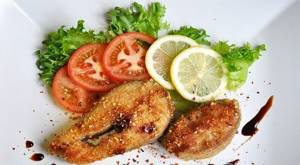
- Now you need to remove the defrosted fish from the packaging, rinse it with cool water and clean it. Each piece of pollock should be rolled in batter on all sides and placed on a hot frying pan greased with vegetable oil. The fish should be fried on medium heat for about 10 - 12 minutes, then pour in the remaining batter, turn each piece over, cover the pan with a lid and continue frying for another 8 - 10 minutes.
Ready pollock should be served immediately after cooking, garnishing each serving with basil leaves.
In a frying pan
Fried pollock fish is a bit dry, but there are recipes that will save the situation. Use marinade or batter.
Pollock fried in kefir marinade
We will need:
- fillet – 500 gr.;
- kefir – half a glass;
- garlic – 1 clove;
- flour – 30 gr.;
- breadcrumbs – 30 gr.;
- frying oil;
- salt, pepper, paprika - to taste.
Rinse and dry the fillet. Cut into pieces, put in a container, add salt, pepper, and pour kefir. Leave in the refrigerator for half an hour.
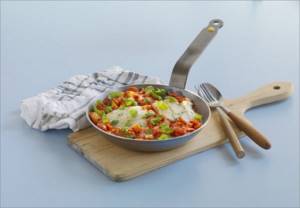
Mix breadcrumbs and flour, add a little salt.
Tip - add paprika to the breading, this will give it a golden color and a harmonious aroma. Lightly shake off the marinated pieces from excess kefir and roll them in the breading mixture, fry in hot oil for literally 3 minutes on each side until golden brown.
